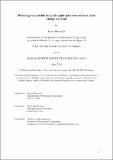| dc.contributor.advisor | Kirchain, Randolph | |
| dc.contributor.author | Bhuwalka, Karan | |
| dc.date.accessioned | 2024-07-10T20:21:46Z | |
| dc.date.available | 2024-07-10T20:21:46Z | |
| dc.date.issued | 2024-05 | |
| dc.date.submitted | 2024-06-13T16:43:22.059Z | |
| dc.identifier.uri | https://hdl.handle.net/1721.1/155648 | |
| dc.description.abstract | The adoption of renewable energy technologies hinges on the availability of many critical minerals. To meet the large demand for critical minerals, it is vital to scale up mineral supply in an environmentally and socially responsible way while maintaining low materials costs for key technologies. To guide policy and technology innovation that meets this objective, we need robust approaches for evaluating the availability and costs of materials. However, traditional approaches for assessing material availability or ‘criticality’ do not incorporate price feedback or a structural understanding of how material supply evolves. In this thesis, I build a model that simulates metal demand, mine opening and operation decisions, and mineral reserve development while incorporating price feedback. This model is used to evaluate how factors such as the rate of demand growth, materials substitutability and recycling rates impact materials prices and availability in the long term. The model is then applied to data on real mining projects for two key battery materials: nickel and lithium. Model simulations analyze supply pathways till 2040 to identify strategies that reduce the risk of materials supply constraints impacting clean energy technology deployment.
Results demonstrate that a combination of high mining productivity, development of material substitutes and large recycling rates reduce the prevalence of availability risks from ~90% to just under 2% for materials experiencing high demand. In the nickel case, results show that environmental regulation can reduce impacts such as supply-chain emissions by 50% but lead to a 2x increase in nickel prices with only 70% of baseline nickel demand being satisfied. However, if regulations are combined with innovation that lowers processing costs and market coordination that reduces project development timelines and risks, over 90% of the demand is met without price increases. Similarly in the lithium case, reducing mine development timelines from 8 years to 6 years can increase the percentage of demand satisfied from 82% to 92% by moderating supply shortages and lithium prices. | |
| dc.publisher | Massachusetts Institute of Technology | |
| dc.rights | Attribution-NonCommercial-NoDerivatives 4.0 International (CC BY-NC-ND 4.0) | |
| dc.rights | Copyright retained by author(s) | |
| dc.rights.uri | https://creativecommons.org/licenses/by-nc-nd/4.0/ | |
| dc.title | Modeling sustainable mineral supply pathways to meet clean energy demand | |
| dc.type | Thesis | |
| dc.description.degree | Ph.D. | |
| dc.contributor.department | Massachusetts Institute of Technology. Department of Mechanical Engineering | |
| dc.identifier.orcid | 0000-0002-1963-6717 | |
| mit.thesis.degree | Doctoral | |
| thesis.degree.name | Doctor of Philosophy | |
